
Derrick Adams, Cool Down Bench (RBG), 2023. Fiberglass, epoxy resin, polyurethane paint, polyurethane clear coat, and Radiata pine. 18 3/8 x 121 7/8 x 23 inches (46.7 x 309.6 x 58.4 cm). Courtesy the artist and Gagosian. © Derrick Adams

Derrick Adams, Cool Down Bench (RBG), 2023. Fiberglass, epoxy resin, polyurethane paint, polyurethane clear coat, and Radiata pine. 18 3/8 x 121 7/8 x 23 inches (46.7 x 309.6 x 58.4 cm). Courtesy the artist and Gagosian. © Derrick Adams

Derrick Adams, That’s Music To My Ears, 2023. Acrylic and fabric collage on wood panel with custom wood fr…
View full credits
Derrick Adams, Floater 107, c. 2017. Acrylic and fabric collage on panel. Approx. 50 x 72 inches (127 x 182.9 cm). Courtesy the artist and Gagosian. © Derrick Adams

Derrick Adams, Style Variation Grid 6, 2019. Acrylic, graphite, and inkjet on watercolor paper. 70 x 44 inches (177.8 x 111.8 cm). Courtesy the artist and Gagosian. © Derrick Adams

Derrick Adams, Cool Down Bench (RBG), 2023. Fiberglass, epoxy resin, polyurethane paint, polyurethane clear coat, and Radiata pine. 18 3/8 x 121 7/8 x 23 inches (46.7 x 309.6 x 58.4 cm). Courtesy the artist and Gagosian. © Derrick Adams

Derrick Adams, That’s Music To My Ears, 2023. Acrylic and fabric collage on wood panel with custom wood fr…
View full credits
Derrick Adams, Floater 107, c. 2017. Acrylic and fabric collage on panel. Approx. 50 x 72 inches (127 x 182.9 cm). Courtesy the artist and Gagosian. © Derrick Adams

Derrick Adams, Style Variation Grid 6, 2019. Acrylic, graphite, and inkjet on watercolor paper. 70 x 44 inches (177.8 x 111.8 cm). Courtesy the artist and Gagosian. © Derrick Adams
“What can I reveal that has not been shown? Black people — not entertaining, just being, living. Letting people deal with that as reality.”
— Derrick Adams
This first mid-career survey of the prolific New York–based artist Derrick Adams (b. 1970 in Baltimore) offers a sweeping view of his multidisciplinary practice over twenty years. Adams celebrates contemporary Black life and culture through a distinct representational language. He often combines planar shapes and patterns to create multifaceted figures that center leisure, freedom, and the pursuit of happiness. Adams’s painting, sculpture, collage, performance, video, and public projects celebrate the beauty of everyday life, transforming these moments into an iconography that resonates with the richness and complexity of Black culture in our time.

Sonya Kelliher-Combs, Red Large Beaded Secrets, 2023. Acrylic polymer, glass bead, nylon thread, cotton muslin, a…
View full credits
Mary Sully, Amelia Earhart, ca. 1920-40. Colored pencil on paper. Three parts, e…
View full credits
Teresa Baker, Knife River, 2024. Yarn, buckskin, artificial sinew, willow on AstroTurf, 63 x 107 inches (160.2 x 271.8 cm). Courtesy the artist and Broadway Gallery. © Teresa Baker

Kimowan Metchewais, Chief’s Blanket, 2002. Paper, ink. 46 7/8 x 70 inches (119 x 178 cm). National Museum of the American Indian, Smithsonian Institution (26/9521). Photo by NMAI photo services.

Dakota Mace, So’ II (Stars II), 2022. Unique arrangement of 40 chemigrams. 38 × 51 inches (96.5 × 129.5 cm). Courtesy the artist and Bruce Silverstein Gallery. © Dakota Mace

Jaune Quick-to-See Smith, Cree Prayer Series #1, 1978. Acrylic and pastel on paper. 22 x 15 inches (…
View full credits
Sonya Kelliher-Combs, Red Large Beaded Secrets, 2023. Acrylic polymer, glass bead, nylon thread, cotton muslin, a…
View full credits
Mary Sully, Amelia Earhart, ca. 1920-40. Colored pencil on paper. Three parts, e…
View full credits
Teresa Baker, Knife River, 2024. Yarn, buckskin, artificial sinew, willow on AstroTurf, 63 x 107 inches (160.2 x 271.8 cm). Courtesy the artist and Broadway Gallery. © Teresa Baker

Kimowan Metchewais, Chief’s Blanket, 2002. Paper, ink. 46 7/8 x 70 inches (119 x 178 cm). National Museum of the American Indian, Smithsonian Institution (26/9521). Photo by NMAI photo services.
An Indigenous Present is a thematic exhibition spanning 100 years of contemporary Indigenous art. The exhibition includes new commissions and significant works by 15 artists who use strategies of abstraction to represent personal and collective narratives, describe specific and imagined places, and build upon cultural and aesthetic traditions. Co-organized by artist Jeffrey Gibson and independent curator Jenelle Porter, the exhibition offers an expansive consideration of Indigenous art practices that highlights a continuum of elders and emerging makers, and premieres newly commissioned site-specific works by Raven Chacon, Caroline Monnet, and Anna Tsouhlarakis.
An Indigenous Present emerges from Gibson and Porter’s 2023 landmark publication of the same name, which, through a collaborative process, brought together work by Native North American artists exploring diverse approaches to concept, form, and medium. Their engagement with artists during the making of the book inspired this exhibition—one that demonstrates the endless variability of abstraction and its capacity to hold multiple forms and histories.
Beyond the works in the galleries, the ICA highlights Native and Indigenous makers in a series of public programs and performances including an installation by artist, author, and poet Robert Peters in the ICA Bank of America Art Lab; performances of Raven Chacon’s scores and soundworks; and a film series curated by artist Sky Hopinka in the ICA Barbara Lee Family Foundation Theater.
An Indigenous Present debuts at the ICA, before traveling to the Frist Art Museum in Nashville (June 26—September 27, 2026) and the Frye Art Museum in Seattle (November 7, 2026—February 14, 2027).
Teresa Baker (Mandan/Hidatsa; born 1985 in Watford City, ND)
Raven Chacon (Diné; born 1977 in Fort Defiance, Navajo Nation)
Sky Hopinka (Ho-Chunk Nation; born 1984 in Bellingham, WA)
Sonya Kelliher-Combs (Iñupiaq/Athabascan; born 1969 in Bethel, AK)
Gabrielle L’Hirondelle Hill (Cree and Métis; born 1979 in Comox, British Columbia)
George Longfish (Seneca and Tuscarora; born 1942 in Ohsweken, Ontario)
Dakota Mace (Diné; born 1991 in Albuquerque, NM)
Kimowan Metchewais (Cree; born 1963 in Oxbow, Saskatchewan; died 2011, St. Paul, Alberta)
Caroline Monnet (Anishinaabe [Algonquin] and French; born 1985 in Ottawa, Ontario)
George Morrison (Ojibwe; born 1919 in Chippewa City, MN; died 2000, Red Rock, MN)
Audie Murray (Cree and Métis; born 1993 in Saskatoon, Saskatchewan)
Jaune Quick-to-See Smith (citizen of the Confederated Salish and Kootenai Nation; born 1940 in St. Ignatius Mission, Flathead Reservation, MT; died 2025, Corrales, NM)
Mary Sully (Susan Mabel Deloria) (Yankton Dakota; born 1896 in Standing Rock Reservation, ND; died 1963, Omaha, NE)
Anna Tsouhlarakis (Navajo/Creek/Greek; born 1977 in Lawrence, KS)
Kay WalkingStick (Cherokee and Anglo; born 1935 in Syracuse, NY)

Charles Atlas, Personalities, 2024. Installation view, Charles Atlas: About Time, the Institute of Contemporary Art/Boston, 2024–25. Photo by Mel Taing.

Charles Atlas, Hail the New Puritan (still), 1986. 16mm film transferred to video (color, sound; 84:54 minutes). Dimensions variable. Courtesy the artist and Luhring Augustine, New York. © C…
View full credits
Charles Atlas, MC⁹, 2012. Installation view, Charles Atlas: About Time, the Institute of Contemporary Art/Boston, 2024–25. Photo by Mel Taing.

Charles Atlas, Personalities, 2024. Installation view, Charles Atlas: About Time, the Institute of Contemporary Art/Boston, 2024–25. Photo by Mel Taing.

Charles Atlas, Hail the New Puritan (still), 1986. 16mm film transferred to video (color, sound; 84:54 minutes). Dimensions variable. Courtesy the artist and Luhring Augustine, New York. © C…
View full credits
Charles Atlas, MC⁹, 2012. Installation view, Charles Atlas: About Time, the Institute of Contemporary Art/Boston, 2024–25. Photo by Mel Taing.

Charles Atlas, Personalities, 2024. Installation view, Charles Atlas: About Time, the Institute of Contemporary Art/Boston, 2024–25. Photo by Mel Taing.
Charles Atlas: About Time is the first U.S. museum survey of the pioneering interdisciplinary artist Charles Atlas (b. 1949 in St. Louis). Spanning 50 years of work, this retrospective is conceived as an immersive environment for the visitor, featuring several monumental multi-channel video installations, or “walk-through experiences,” as the artist describes them. To create these installations, Atlas “explodes” single-channel videos into new configurations, presenting the videos on multiple suspended screens and monitors around the gallery, so visitors can move between and among them.
Atlas’s early career is defined by his time as filmmaker-in-residence at the Merce Cunningham Dance Company, New York. Atlas and Cunningham created the genre of “media-dance”: dance made for the camera, rather than an in-person audience, wherein the camera moves seamlessly in concert with the dancers. Since leaving the Merce Cunningham Dance Company in 1983, Atlas has been a leading figure in film and video art, and one of the preeminent artists to capture dance and performance for the camera through groundbreaking collaborations with Michael Clark, Yvonne Rainer, Leigh Bowery, Marina Abramović, Rashaun Mitchell, and Silas Riener, and many others. Much of Atlas’s genre-defying, collaborative work has proved prescient for a generation of artists working today. Contemporary concerns such as the creative possibilities of performance and portraiture on camera and the political urgency of challenging conventions of gender, sexuality, and queer identity have been at the heart of Atlas’s creative output for decades.
Charles Atlas is oriented around the artist’s groundbreaking work at the intersections of moving image, dance, and performance, and his intimate video portraits of close collaborators and friends. The shifting political and cultural landscape of the United States from the 1970s to the present acts as a backdrop to this dynamic visual exhibition, addressing themes of performance and portraiture, gender and sexuality, and collaboration and friendship.

Installation view, Huma Bhabha: They Live, the Institute of Contemporary Art/Boston, 2019. Photo by Charles Mayer Photography © Huma Bhabha

Huma Bhabha, My Skull Is Too Small (detail), 2009. Clay, wood, wire, Styrofoam, aluminum, c…
View full credits
Installation view, Huma Bhabha: They Live, the Institute of Contemporary Art/Boston, 2019. Photo by Natasha Moustache © Huma Bhabha

Huma Bhabha, Four Nights of a Dreamer, 2018. Cork, Styrofoam, acrylic, oil stick, and lacquere…
View full credits
Installation view, Huma Bhabha: They Live, the Institute of Contemporary Art/Boston, 2019. Photo by Charles Mayer Photography © Huma Bhabha

Huma Bhabha, Constantium, 2014. Cast bronze with acrylic paint. 73 3/4 x 26 1/8 x 19 7/8 (187.…
View full credits
Installation view, Huma Bhabha: They Live, the Institute of Contemporary Art/Boston, 2019. Photo by Charles Mayer Photography © Huma Bhabha

Installation view, Huma Bhabha: They Live, the Institute of Contemporary Art/Boston, 2019. Photo by Charles Mayer Photography © Huma Bhabha

Huma Bhabha, My Skull Is Too Small (detail), 2009. Clay, wood, wire, Styrofoam, aluminum, c…
View full credits
Installation view, Huma Bhabha: They Live, the Institute of Contemporary Art/Boston, 2019. Photo by Natasha Moustache © Huma Bhabha

Huma Bhabha, Four Nights of a Dreamer, 2018. Cork, Styrofoam, acrylic, oil stick, and lacquere…
View full creditsSince the early 1990s, Huma Bhabha (born 1962 in Karachi) has developed a distinct visual vocabulary that draws upon a wide variety of influences, including horror movies, science fiction, ancient artifacts, religious reliquary, and modernist sculpture. The largest survey of the artist’s work to date, Huma Bhabha: They Live encompasses sculpture, drawing, and photography, with a special focus on Bhabha’s engagement with the human figure.
Best known for her sculptures, Bhabha uses a diverse array of natural, industrial, and found materials to make compelling works that engage the arts and histories of diverse cultures. Her work transcends a singular time and place, instead creating an exploration of what she describes as the “eternal concerns” found across all cultures: war, colonialism, displacement, and memories of home.
Huma Bhabha: They Live also includes drawings, photographs, and prints spanning the past two decades, as well as new works made on the occasion of this exhibition. It is accompanied by a lushly illustrated scholarly publication.

William Forsythe, Alignigung (still), 2017. Video (color, sound; 15:50 minutes). Courtesy the artist and Gagosian, New York. © William Forsythe

William Forsythe, Towards the Diagnostic Gaze, 2013. Feather duster, locally sourced stone, and instructions (engraved). 2 x 31 1/2 x 17 3/4 inches (5 x 80 x 45 cm). Photo by Dominik Mentzos. © William Forsythe

William Forsythe, The Fact of Matter, 2009. Installation view, William Forsythe: Choreographic Objects, the Institute of Contemporary Art/Boston, 2018. Photo by Liza Voll. © William Forsythe

William Forsythe, Nowhere and Everywhere at the Same Time, No. 3, 2015. Installation view, William Forsythe: The Fact of Matter, Museum für Moderne Kunst Frankfurt am Main, Germany, 2015. Photo by Dominik Mentzos…
View full credits
William Forsythe, Alignigung (still), 2017. Video (color, sound; 15:50 minutes). Courtesy the artist and Gagosian, New York. © William Forsythe

William Forsythe, Towards the Diagnostic Gaze, 2013. Feather duster, locally sourced stone, and instructions (engraved). 2 x 31 1/2 x 17 3/4 inches (5 x 80 x 45 cm). Photo by Dominik Mentzos. © William Forsythe

William Forsythe, The Fact of Matter, 2009. Installation view, William Forsythe: Choreographic Objects, the Institute of Contemporary Art/Boston, 2018. Photo by Liza Voll. © William Forsythe

William Forsythe, Nowhere and Everywhere at the Same Time, No. 3, 2015. Installation view, William Forsythe: The Fact of Matter, Museum für Moderne Kunst Frankfurt am Main, Germany, 2015. Photo by Dominik Mentzos…
View full creditsThe ICA presents the first comprehensive American exhibition of performative objects, video installations, and interactive sculptures of the internationally celebrated choreographer William Forsythe.
World renowned, Forsythe is counted among the foremost choreographers of our time. For over four decades he has created productions that redefine classical ballet’s vocabulary, and his groundbreaking approach to choreography, staging, lighting, and dance analysis has influenced countless choreographers and artists. Since the 1990s, parallel to his stage productions, Forsythe has developed installations, sculptures, and films that he calls Choreographic Objects. Blurring the lines between performance, sculpture, and installation, his Choreographic Objects invite the viewer to engage with the fundamental ideas of choreography. These site-responsive, interactive works are designed to stimulate movement from visitors through interactions with kinetic sculptures, video projections, and architectural environments. The exhibition features large-scale installations, including several works developed for the ICA. Via the artist’s instructions for action posted on the wall next to the works, visitors are invited to move freely through the performative exhibition and generate an infinite range of individual choreographies.
William Forsythe: Choreographic Objects coincides with Forsythe’s five-year residency at the Boston Ballet, providing audiences with instrumental insight into his pioneering choreographic work across different platforms. Catch a new world premiere in Full on Forsythe March 7–17, 2019.
The exhibition is accompanied by a richly illustrated publication featuring writers from the disciplines of both dance and art.
Timed tickets are required on weekends, February vacation week (Feb 18-21), and President’s Day in order to ensure an enjoyable experience for all. Tickets will be available on site only on a first-come, first-served basis. Tickets are limited and do sell out. We recommend arriving early on weekends or visiting during the week to secure tickets.
ICA Members do not need a timed ticket, and are always guaranteed entry into the exhibition. Become a member today!
Admission is free for youth 17 and younger, but tickets are still required.
Please note: timed tickets do not guarantee that there will not be wait times for certain artworks.
We ask that you engage in the works in William Forsythe in a way that promotes your own safety, is mindful of others’ experiences and safety, and respects the safety of the artwork. Note that all participation is voluntary and at the visitor’s own risk. The ICA will not assume responsibility for any injury, loss, or damage incurred.
− Please remove coats and bags before entering interactive works of art.
− No running or jumping.
− Please follow the artist’s guiding instructions, posted near the artworks, on how to participate with each piece.
The Fact of Matter
Artist’s instructions: PLEASE TRAVERSE THE SPACE USING ONLY THE RINGS.
− Participation time in this work may be limited to 5 minutes during timed ticketing periods and at the discretion of gallery staff. Eight visitors may participate at one time.
− Minors 12 years and under must be monitored by an accompanying adult.
− The Fact of Matter is not recommended for children younger than 6. Participation for children younger than 6 is at the discretion of accompanying adults and with close supervision only.
Nowhere and Everywhere at the Same Time, No. 3
Artist’s instructions: PLEASE ENTER, AVOIDING ANY CONTACT WITH THE PENDULUMS.
− No more than 10 visitors may actively engage at one time.
− For safety reasons, wheelchairs, strollers, and children younger than 3 may not enter the work.
− If you get twisted in a pendulum, please detangle yourself carefully so the pendulum remains in place. If you need help, Visitor Assistants are available in the gallery to assist you.
Video
While recording video is not allowed in other parts of the ICA, the recording of non-video artworks and experiences is allowed within this exhibition.
This exhibition William Forsythe: Choreographic Objects invites visitors to interact with a variety of objects and environments in unexpected ways. Below are a few frequently asked questions.
Can I touch the work?
In most cases, yes! Participants are invited to interact with many of the artworks on view according to the artist’s instructions, which are provided on labels next to the artworks. Each label also includes interpretive descriptions and a symbol indicating whether it is okay to touch the work. We kindly ask that visitors do not touch the video screens and projectors.
Can I participate physically without a dance background?
Yes! Forsythe believes choreography is for everybody, not just those with a dance background. He also believes choreography can arise anywhere, not just on the theater stage. For Forsythe, dance and choreography are different and can exist independently of each other. As he notes, “Choreography is not necessarily bound to dance, nor is dance bound to choreography, for that matter—you can just get up and dance.”
What If I am not able to interact with all the works?
There is no “right way” to interact with Choreographic Objects. Each visitor will approach the works differently and, in the process of trying to solve the problems they pose, may gain a new understanding of movement or of their body. We encourage visitors of all ages and abilities to interact with the works however they wish—whether through physical interaction, observing others, or considering the range of experiences presented on tablets within the galleries. If you visit with friends or family, you might try some of the interactive works together and talk about your experiences—you may find that they vary greatly.
Are these works appropriate for kids?
Yes! Many kids will love interacting with the Choreographic Objects. In fact, children often intuitively embody the trial-and-error processes of action-based knowledge that Forsythe is exploring. We request that parents and caretakers determine if their child can participate physically and oversee and remain with children while they interact with the works. Two works have age restrictions: For The Fact of Matter, minors 12 and under must be monitored by an accompanying adult, and the work is not recommended for children younger than 6—participation for children younger than 6 is at the discretion of accompanying adults and with close supervision only. For safety reasons, children younger than 3 may not enter Nowhere and Everywhere at the Same Time.
Some of these works are difficult or impossible to do. Why?
Ideas of physical limitation, the illusion of weightlessness, the productivity of failure, and the heroism of persevering in difficult situations have been steadfast concerns of Forsythe on stage and beyond. In many Choreographic Objects, participants are compelled to consider both the body’s physical capacities and its limitations as part of his investigation of action-based knowledge. For him, trial and error remains a productive means of learning. Some of the works are indeed nearly impossible; visitors are encouraged to attempt and experience the works however they wish.
Can I take video of these artworks?
Although video recording is typically against ICA policy, it is allowed within William Forsythe: Choreographic Objects, with the exception of video works. We encourage you to share your experience of the work and appreciate your considering other museum visitors by taking video in an unobtrusive manner.
Additional background
William Forsythe was born in New York in 1949, and resides in Vermont. Trained in classical ballet in Florida and New York, Forsythe joined the Stuttgart Ballett in 1973 and went on to direct the Ballett Frankfurt for twenty years. He directed the smaller, more specialized Forsythe Company, in Frankfurt and Dresden, from 2005 to 2015. His Choreographic Objects have been exhibited globally in venues such as Tate Modern’s Turbine Hall, the Venice and Sydney Biennales, La Villette/Grande Halle, Paris as part of Festival d’automne, and museums such as Wexner Center for the Arts, Columbus, Ohio, Museum fur Moderne Kunst, Frankfurt, and Hayward Gallery, London. He has received numerous awards and in 2010 was honored with the Golden Lion for Lifetime Achievement at the Venice Biennale.

Installation view, Virgil Abloh: “Figures of Speech,” the Institute of Contemporary Art/Boston, July 3–September 26, 2021. Photo by Mel Taing.

Installation view, Virgil Abloh: “Figures of Speech,” the Institute of Contemporary Art/Boston, July 3–September 26, 2021. Photo by Mel Taing.

Installation view, Virgil Abloh: “Figures of Speech,” the Institute of Contemporary Art/Boston, July 3–September 26, 2021. Photo by Mel Taing.

Installation view, Virgil Abloh: “Figures of Speech,” the Institute of Contemporary Art/Boston, July 3–September 26, 2021. Photo by Mel Taing.

Installation view, Virgil Abloh: “Figures of Speech,” the Institute of Contemporary Art/Boston, July 3–September 26, 2021. Photo by Mel Taing.

Installation view, Virgil Abloh: “Figures of Speech,” the Institute of Contemporary Art/Boston, July 3–September 26, 2021. Photo by Mel Taing.

Installation view, Virgil Abloh: “Figures of Speech,” the Institute of Contemporary Art/Boston, July 3–September 26, 2021. Photo by Mel Taing.

Installation view, Virgil Abloh: “Figures of Speech,” the Institute of Contemporary Art/Boston, July 3–September 26, 2021. Photo by Mel Taing.
Virgil Abloh: “Figures of Speech” is the first museum exhibition devoted to the work of the genre-bending artist and designer Virgil Abloh (b. 1980, Rockford, IL). Abloh pioneers a practice that cuts across media and connects visual artists, musicians, graphic designers, fashion designers, and architects.
Abloh cultivated an interest in design and music at an early age, finding inspiration in the urban culture of Chicago. While pursuing a master’s degree in architecture from the Illinois Institute of Technology, he worked on album covers, concert designs, and merchandising. In 2013, Abloh founded his stand-alone fashion brand Off-White™ in Milan, Italy, and, in 2018, assumed the position of artistic director of Louis Vuitton’s menswear.
Organized by the Museum of Contemporary Art Chicago and set in an immersive space designed by Rem Koolhaas’s renowned architecture firm OMA*AMO, the exhibition will offer an in-depth look at defining highlights of Abloh’s career, including signature clothing collections, video documentation of iconic fashion shows, distinctive furniture and graphic design work, and collaborative projects with contemporary artists. A program of cross-disciplinary offerings will mirror the artist’s range of interests across music and design.
Explore the companion pop-up store, “Church & State”
Explore an Abloh-inspired zine by ICA Teens

Monir Shahroudy Farmanfarmaian, Mugamas One, 2012. Mirror, reverse painted glass, and plaster on wood 32 × 45 × 31 1/2 inches (81.3 × 114.3 × 80 cm). Installation view, Less Is a Bore: Maximalist Art & Design, the Ins…
View full credits
Installation view, Virgil Marti, Less Is a Bore: Maximalist Art & Design, the Institute of Conte…
View full credits
Joyce Kozloff, If I Were an Astronomer: Boston, 2015. Mixed media on canvas. 37 x 55 in. (94 x 139.7 cm). Courtesy the artist and DC Moore Gallery, New York © Joyce Kozloff

Installation view, Less Is a Bore: Maximalist Art & Design, the Institute of Contemporary Art/Boston, 2019. Photo by Meg Elkinton and Shane Godfrey

Franklin Williams, Yellow Apron, 1970. Acrylic, fabric, yarn, and nails on canvas. 40 × 48 inches (101.6 × 121.9 cm). Courtesy the artist and Parker Gallery, Los Angeles. © Fran…
View full credits
Kehinde Wiley, The Sisters Zenaide and Charlotte Bonaparte, 2014. Oil on linen, 84 x 63 in. (213.4 x 160 c…
View full credits
Installation view, Less Is a Bore: Maximalist Art & Design, the Institute of Contemporary Art/Boston, 2019. Photo by Meg Elkinton and Shane Godfrey

Installation view, Less Is a Bore: Maximalist Art & Design, the Institute of Contemporary Art/Boston, 2019. Photo by Meg Elkinton and Shane Godfrey

Monir Shahroudy Farmanfarmaian, Mugamas One, 2012. Mirror, reverse painted glass, and plaster on wood 32 × 45 × 31 1/2 inches (81.3 × 114.3 × 80 cm). Installation view, Less Is a Bore: Maximalist Art & Design, the Ins…
View full credits
Installation view, Virgil Marti, Less Is a Bore: Maximalist Art & Design, the Institute of Conte…
View full credits
Joyce Kozloff, If I Were an Astronomer: Boston, 2015. Mixed media on canvas. 37 x 55 in. (94 x 139.7 cm). Courtesy the artist and DC Moore Gallery, New York © Joyce Kozloff

Installation view, Less Is a Bore: Maximalist Art & Design, the Institute of Contemporary Art/Boston, 2019. Photo by Meg Elkinton and Shane Godfrey
How artists have used ornamentation to transform craft and design, feminism, queerness and gender, beauty and taste, camouflage and masquerade, and multiculturalism and globalism.
Less Is a Bore: Maximalist Art & Design brings together works in painting, sculpture, ceramic, dance, furniture design, and more that privilege decoration, pattern, and maximalism.
Borrowing its attitude from architect Robert Venturi’s witty retort to Mies van der Rohe’s modernist edict “less is more,” Less Is a Bore shows how artists, including those affiliated with the Pattern & Decoration movement of the 1970s, have sought to rattle the dominance of modernism and minimalism. Encouraged by the pluralism permeating many cultural spheres at the time, these artists accommodated new ideas, modes, and materials, challenging entrenched categories that marginalized non-Western art, fashion, interior design, and applied art.
The exhibition considers how artists have used ornamentation, pattern painting, and other decorative modes to critique, subvert, and transform accepted histories related to craft and design, feminism, queerness and gender, beauty and taste, camouflage and masquerade, and multiculturalism and globalism. More recent artworks in the exhibition chart both the legacy and transformation of these trajectories.
Spanning generations, geographies, and traditions, Less Is a Bore includes works ranging from experiments in patterning by Sanford Biggers, Jasper Johns, and Miriam Schapiro to the transgressive sculpture and furniture of Lucas Samaras and Ettore Sottsass, to the installations of Polly Apfelbaum, Nathalie du Pasquier, and Virgil Marti.
Ron Amstutz (b. 1968, Youngstown, OH)
Polly Apfelbaum (b. 1955, Abington Township, PA)
Jennifer Bartlett (b. 1941, Long Beach, CA)
Sanford Biggers (b. 1970, Los Angeles)
Tord Boontje (b. 1968, Enschende, The Netherlands)
Leigh Bowery (b. 1961, Sunshine, Australia; d. 1995, London) and Fergus Greer (b. England)
Roger Brown (b. 1941, Hamilton, AL; d. 1997, Atlanta)
Taylor Davis (b. 1959, Palm Springs, CA)
Nathalie Du Pasquier (b. 1957, Bordeaux, France)
Monir Shahroudy Farmanfarmaian (b. 1922, Qazvin, Iran; d. 2019, Tehran, Iran)
Jeffrey Gibson (b. 1972, Colorado Springs, CO)
Nancy Graves (b. 1939, Pittsfield, MA; d. 1995, New York)
Valerie Jaudon (b. 1945, Greenville, MS)
Jasper Johns (b. 1930, Augusta, GA)
Joyce Kozloff (b. 1942, Somerville, NJ)
Robert Kushner (b. 1949, Pasadena, CA)
Ellen Lesperance (b. 1971, Minneapolis)
Sol LeWitt (b. 1928, Hartford, CT; d. 2007, New York)
Liza Lou (b. 1969, New York)
Babette Mangolte (b. 1941, Montmorot, France) and Lucinda Childs (b. 1940, New York)
Virgil Marti (b. 1962, St. Louis)
Dianna Molzan (b. 1972, Tacoma, WA)
Joel Otterson (b. 1959, Los Angeles)
Laura Owens (b. 1970, Euclid, OH)
Howardena Pindell (b. 1943, Philadelphia)
Lari Pittman (b. 1952, Los Angeles)
Ruth Root (b. 1967, Chicago)
Lucas Samaras (b. 1936, Kastoria, Greece)
Zoe Pettijohn Schade (b. 1973, Boston)
Miriam Schapiro (b. 1923, Toronto; d. 2015, Hampton Bays, NY)
Ettore Sottsass (b. 1917, Innsbruck, Austria; d. 2007, Milan)
Frank Stella (b. 1936, Malden, MA)
Stephanie Syjuco (b. 1974, Manila, Philippines)
Philip Taaffe (b. 1955, Elizabeth, NJ)
Venturi, Scott Brown & Associates (founded 1960 as Venturi & Associates, Philadelphia)
Marcel Wanders (b. 1963, Boxtel, The Netherlands)
Pae White (b. 1963, Pasadena, CA)
Kehinde Wiley (b. 1977, Los Angeles)
Franklin Williams (b. 1940, Ogden, UT)
Betty Woodman (b. 1930, Norwalk, CT; d. 2018, New York)
Christopher Wool (b. 1955, Chicago)
Haegue Yang (b. 1971, Seoul)
Ray Yoshida (b. 1930, Kapaa, Hawaii, HI; d. 2009, Kauai, HI)
Robert Zakanitch (b. 1935, Elizabeth, NJ)
The exhibition is accompanied by a fully illustrated publication with essays by Elissa Auther, Amy Goldin, and Jenelle Porter.
Please note: One work in this exhibition contains a video with rapidly changing, high-contrast imagery that creates a flashing effect.

Tania Bruguera, Diginity has no nationality, 2017. Installation view, When Home Won’t Let You Sta…
View full credits
Installation view, When Home Won’t Let You Stay: Migration through Contemporary Art, Institute of Contemporary Art/Boston, 2019. Photo by Mel Taing. © Richard Misrach and Guillermo Galindo

Reena Saini Kallat, Woven Chronicle, 2011-19. Installation view, When Home Won’t Let You Stay: Migration through Contemporary Art, Institute of Contemporary Art/Boston, 2019. Photo by Mel Taing. © Reena Saini Kal…
View full credits
Aliza Nisenbaum, La Talaverita, Sunday Morning NY Times, 2016. Oil on linen, 68 x 88 inches (172.7 x 223.5 cm). Courtesy the artist; Anton Kern Gallery, New York; and Mary Mary, Glasgo…
View full credits
Installation view, When Home Won’t Let You Stay: Migration through Contemporary Art, Institute of Contemporary Art/Boston, 2019. Photo by Mel Taing © Do Ho Suh

Yinka Shonibare CBE, The American Library, 2018. Installation view, When Home Won’t Let You Stay: Migration through Contemporary Art, Institute of Contemporary Art/Boston, 2019. Photo by Mel Taing. © Yinka Shonibar…
View full credits
Isaac Julien, Western Union: small boats, 2007. Three-channel video installation, 35mm film transferred to DVD/HD (color, 5.1 surround sound; 18:22 minutes). Dimensions variable. Instal…
View full credits
Mona Hatoum, EXODUS II, 2002. Compressed card, leather, metal and human hair, 50 x 66 x 66 cm (19 3/4 x 26 x 26 in.). Photo by…
View full credits
Tania Bruguera, Diginity has no nationality, 2017. Installation view, When Home Won’t Let You Sta…
View full credits
Installation view, When Home Won’t Let You Stay: Migration through Contemporary Art, Institute of Contemporary Art/Boston, 2019. Photo by Mel Taing. © Richard Misrach and Guillermo Galindo

Reena Saini Kallat, Woven Chronicle, 2011-19. Installation view, When Home Won’t Let You Stay: Migration through Contemporary Art, Institute of Contemporary Art/Boston, 2019. Photo by Mel Taing. © Reena Saini Kal…
View full credits
Aliza Nisenbaum, La Talaverita, Sunday Morning NY Times, 2016. Oil on linen, 68 x 88 inches (172.7 x 223.5 cm). Courtesy the artist; Anton Kern Gallery, New York; and Mary Mary, Glasgo…
View full creditsInternational artists respond to the migration, immigration, and displacement of peoples today, in works ranging from personal accounts to poetic meditations.
When Home Won’t Let You Stay: Migration through Contemporary Art considers how contemporary artists are responding to the migration, immigration, and displacement of peoples today. We are currently witnessing the highest levels of movement on record—the United Nations estimates that one out of every seven people in the world is an international or internal migrant who moves by choice or by force, with great success or great struggle. When Home Won’t Let You Stay borrows its title from a poem by Warsan Shire, a Somali-British poet who gives voice to the experiences of refugees. Through artworks made since 2000 by twenty artists from more than a dozen countries — such as Colombia, Cuba, France, India, Iraq, Mexico, Morocco, Nigeria, Palestine, South Korea, the United Kingdom, and the United States — this exhibition highlights diverse artistic responses to migration ranging from personal accounts to poetic meditations, and features a range of mediums, including sculpture, installation, painting, and video. Artists in the exhibition include Kader Attia, Tania Bruguera, Isaac Julien, Hayv Kahraman, Reena Saini Kallat, Richard Mosse, Carlos Motta, Yinka Shonibare, Xaviera Simmons, and Do-Ho Suh, among others. A fully illustrated catalogue accompanies the exhibition, with an essay by Eva Respini and Ruth Erickson and texts by prominent scholars Aruna D’Souza, Okwui Enwezor, Thomas Keenan, Peggy Levitt, and Uday Singh Mehta, among others.
The ICA is extremely grateful to the generosity and input of the following advisors, who shared input on the exhibition and its language, programming, didactics, and outreach, over the course of several meetings:
Local organizations NuLawLab, Maverick Landing Community Services, ZUMIX, and the Golden Stairs Immigration Center in East Boston have been instrumental to Boston artist and advisory board member Anthony Romero’s community-based project …first in thought, then in action.
For further information on immigration and how you might lend or seek assistance, we refer you to local, national, and international organizations below. If you have recommendations of other organizations, please email info@icaboston.org.
ACLU of Massachusetts
Massachusetts Immigrant and Refugee Advocacy Coalition
City of Boston’s Immigrant Advancement Department (through the Mayor’s Office)
Political Asylum/Immigrant Representation (PAIR) Project
Berkshire Immigrant Center
East Boston Ecumenical Community Council
Centro Presente
International Institute of New England
The Immigrant Learning Center
Boston International Newcomers Academy (BINCA)
Re-imagining Migration
Irish International Immigrant Center
Greater Boston Legal Services
Boston Center for Refugee Health & Human Rights
Mass.gov: Office for Refugees & Immigrants
DHS: Yearbook of Immigration Statistics
Asian American Civic Association
North American Indian Center of Boston
The Inter-University Committee on International Migration, with MIT, Boston University, Brandeis University, Fletcher School of Law and Diplomacy, Harvard University, Tufts University, and Wellesley
Boston Center for Refugee Health & Human Rights at Boston Medical Center
De Novo Center for Justice and Healing
American Society for International Law
International Criminal Court
DePaul University International Human Rights Law
Legal Research of International Law Issues Using the Internet
University of Minnesota Human Rights Library
Immigration Lawyers on the Web
The Political Asylum/ Immigration Representation Project
American Immigration Lawyers Association
Massachusetts Immigrant and Refugee Advocacy Coalition
The Refugee Media Project
National Consortium of Torture Treatment Programs (NCTTP)
The Center for Victims of Torture (CVT)
HealTorture.org
Affordable Care Act Resources for Refugees
Catholic Charities Archdiocese of Boston
United Nations High Commissioner for Refugees
American Immigration Council
International Committee of the Red Cross
Doctors without Borders
International Organization for Migration
CASA
Junta for Progressive Action
Maine People’s Alliance
Make the Road New York
Massachusetts Immigrant and Refugee Advocacy Coalition (MIRA)
New Hampshire Alliance for Immigrant Rights
Pennsylvania Immigration and Citizenship Coalition (PICC)
The New York Immigration Coalition (NYIC)
American Civil Liberties Union (ACLU)
American Immigration Council
International Rescue Committee
Migration Policy Institute
National Immigration Law Center
Pew Research Center
Refugee and Immigrant Center for Education and Legal Services (RAICES)
Refugee Council USA
Refugees International
US Committee for Refugees and Immigrants
After its conclusion in Boston, When Home Won’t Let You Stay will travel to the Minneapolis Institute of Arts, Minneapolis from February 23 to August 23, 2020, and to the Iris and Gerald B. Cantor Center for the Visual Arts at Stanford University February 5 to May 31, 2021.

Installation view, Deana Lawson, ICA/Boston, 2021. Photo by Mel Taing.

Installation view, Deana Lawson, ICA/Boston, 2021. Photo by Mel Taing.

Deana Lawson, Hair Advertisement, 2005. Pigment print. Courtesy the artist; Sikkema Jenkins & Co., New York; and David Kordansky, Los Angeles. © Deana Lawson

Installation view, Deana Lawson, ICA/Boston, 2021. Photo by Mel Taing.

Installation view, Deana Lawson, ICA/Boston, 2021. Photo by Mel Taing.

Installation view, Deana Lawson, ICA/Boston, 2021. Photo by Mel Taing.

Deana Lawson, Hair Advertisement, 2005. Pigment print. Courtesy the artist; Sikkema Jenkins & Co., New York; and David Kordansky, Los Angeles. © Deana Lawson

Installation view, Deana Lawson, ICA/Boston, 2021. Photo by Mel Taing.
“I photograph family, friends, and strangers, and I operate on the belief that my own being is found in union with those I take pictures of.”
—Deana Lawson
This exhibition is the first museum survey dedicated to the work of Deana Lawson (b. 1979 in Rochester, NY), a singular voice in photography today. For more than 15 years, Lawson has been investigating and challenging conventional representations of Black life through a wide spectrum of photographic languages, including the family album, studio portraiture, staged tableaux, documentary pictures, and appropriated images. Engaging acquaintances as well as strangers she meets on the street, Lawson meticulously poses her subjects in highly staged photographs that picture narratives of family, love, and desire, and create what the artist describes as “a mirror of everyday life, but also a projection of what I want to happen. It’s about setting a different standard of values and saying that everyday Black lives, everyday experiences, are beautiful, and powerful, and intelligent.”
This survey exhibition will include a selection of photographs from 2004 to the present, and will be accompanied by a fully illustrated scholarly catalogue, featuring the voices and perspectives of a variety of scholars, historians, and writers. Deana Lawson will travel to MoMA PS1 April 14–September 5, 2022 and to the High Museum October 7, 2022–February 19, 2023.
Explore the Deana Lawson Family Resource Guide
Hear from the curators, community members, artists, and more on the ICA Digital Guide

Sterling Ruby, SCXV3ST/BD, 2012. Fiberglass, wood, spray paint, and formica 120 × 34 × 34 inches (304.8 × 86.4 × 86.4 cm). Courtesy Sterling Ruby Studio, Los Angeles. Photo by Robert Wedemeyer. © Sterling Ruby

Sterling Ruby, FLAG/QUILT (6625), 2018. Bleached denim, treated fabric, and elastic 164 × 170 inches (416.6 × 431.8 cm). Courtesy Sterling Ruby Studio, Los Angeles. Photo by Robert Wedemeyer. © Sterling Ruby

Installation view, Sterling Ruby, Institute of Contemporary Art/Boston, 2020. Courtesy Sterling Ruby Studio, Los Angeles. Photo by Mel Taing. © Sterling Ruby

Installation view, Sterling Ruby, Institute of Contemporary Art/Boston, 2020. Courtesy Sterling Ruby Studio, Los Angeles. Photo by Mel Taing. © Sterling Ruby

Sterling Ruby, ACTS/WS ROLLIN, 2011. Clear urethane block, dye, wood, spray paint, and formica, 60 1/2 x 62 1/2 x 34 inches (153.7 x 158.8 x 86.4 cm). Photo by Robert Wedemeyer. Courtesy Sterling Ruby Studio, Los Angeles. © Sterling Ruby Studio

Sterling Ruby. ECLPSE (RBGBCROSS), 2015. Collage and paint on cardboard. 121 1/8 × 77 3/4 inches (307.7 × 197.5 cm. Photo by Robert Wedemeyer. Courtesy Sterling Ruby Studio, Los Angeles. © Sterling Ruby

Sterling Ruby, Blue Angel, 2007. Ceramic, 16 1/2 × 18 × 19 1/2 inches (41.9 × 45.7 × 49.5 cm). Courtesy Sterling Ruby Studio, Los Angeles. Photo by Robert Wedemeyer. © Sterling Ruby

Sterling Ruby, SCXV3ST/BD, 2012. Fiberglass, wood, spray paint, and formica 120 × 34 × 34 inches (304.8 × 86.4 × 86.4 cm). Courtesy Sterling Ruby Studio, Los Angeles. Photo by Robert Wedemeyer. © Sterling Ruby

Sterling Ruby, FLAG/QUILT (6625), 2018. Bleached denim, treated fabric, and elastic 164 × 170 inches (416.6 × 431.8 cm). Courtesy Sterling Ruby Studio, Los Angeles. Photo by Robert Wedemeyer. © Sterling Ruby

Installation view, Sterling Ruby, Institute of Contemporary Art/Boston, 2020. Courtesy Sterling Ruby Studio, Los Angeles. Photo by Mel Taing. © Sterling Ruby

Installation view, Sterling Ruby, Institute of Contemporary Art/Boston, 2020. Courtesy Sterling Ruby Studio, Los Angeles. Photo by Mel Taing. © Sterling Ruby
ICA/Boston presents the first comprehensive museum survey for American artist Sterling Ruby.
The exhibition features more than 70 works that demonstrate the relationship between material transformation in Ruby’s practice and the rapid evolution of culture, institutions, and labor. Spanning more than two decades of the artist’s career, the exhibition looks to the origins and development of his practice, through mediums ranging from lesser-known drawings and sculptures to his renowned ceramics and paintings.
Since his earliest works, Ruby has investigated the role of the artist as an outsider. Critiquing the structures of modernism and traditional institutions, Ruby addresses the repressed underpinnings of U.S. culture and the coding of power and violence. Craft is central to his inquiry, as he explores California’s radical ceramics history and traditions of Amish quilt making, shaped by his upbringing in Pennsylvania Dutch country. The process of combining disparate elements is central to Ruby’s material reclamations, which serve as a form of autobiographical and cultural archeology. Organized loosely by chronology and medium, Sterling Ruby considers the artist’s explorations of these themes across the many materials and forms he has utilized throughout his practice.
Sterling Ruby is co-presented with Institute of Contemporary Art, Miami, and is accompanied by an illustrated scholarly catalogue edited by Alex Gartenfeld and Eva Respini, with a conversation between Ruby and Isabelle Graw. Published with DelMonico Prestel, the catalogue features essays that consider Ruby’s work amidst the contemporary art production and visual culture of the last 30 years.
Sterling Ruby (American/Dutch, b. 1972, Germany) is a leading contemporary artist whose work has been presented in solo exhibitions throughout the globe. Ruby received his B.F.A. in 2002 from the School of the Art Institute of Chicago, Illinois, and his M.F.A. in 2005 from the Art Center College of Design, Pasadena. He currently lives and works in Los Angeles.
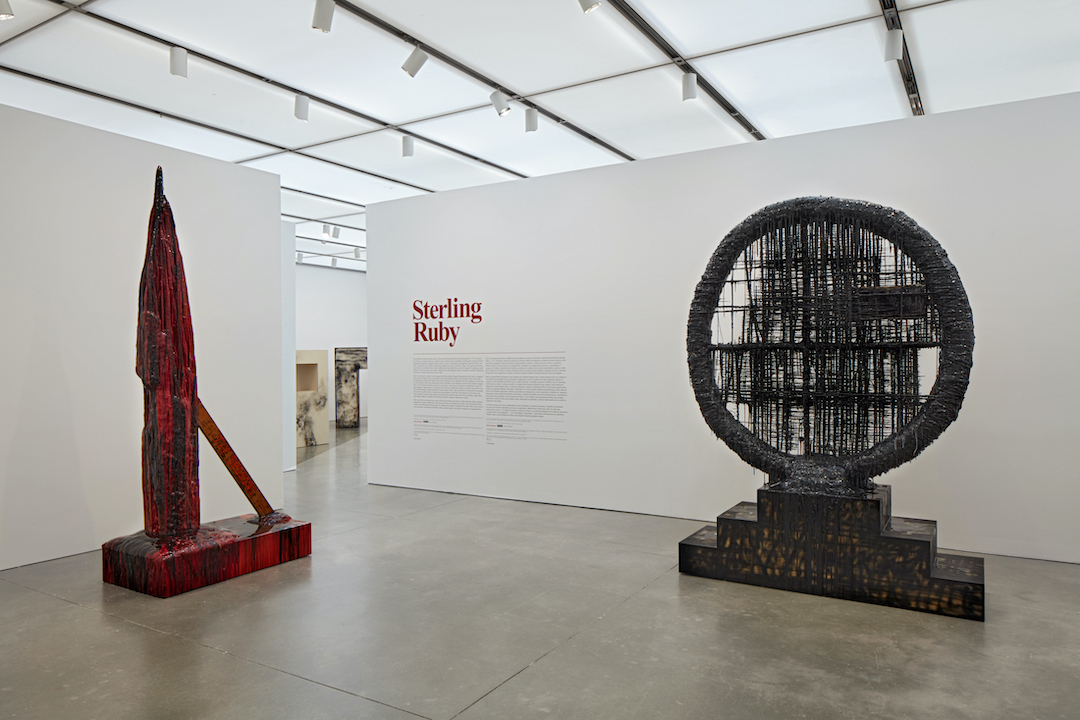
Installation view, Sterling Ruby, Institute of Contemporary Art/Boston, 2020. Courtesy Sterling Ruby Studio, Los Angeles. Photo by Charles Mayer. © Sterling Ruby
In 2006 Ruby began making monumental sculptures from poured urethane (a type of plastic) that aim to capture the gestural, expres-sionistic quality of his ceramics without limits to scale. These works take at least several months to complete because the artist pours small batches of liquid urethane over an armature in layers, working quickly before the urethanes solidifies. As a final step, color is applied as a kind of “tinting dye” with glossy coats of clear urethane. Often used for Hollywood prop-making, urethane is a recurring material in Ruby’s sculptural works. The time-sensitive quality of the material is key to the labor-intensive process and self-evident as an aesthetic gesture. The finish sculptures appear wet, as if they are still in formation. In 2007, after years of experimentation, Ruby settled on the recognizable form of his Monument Stalagmites (2005–13)—tall, upright accumulations supported by a wooden crutch on a low formica plinth.
Black Star/Prostitute’s Bolster, 2007
PVC pipe, urethane, wood, aluminum, and spray paint
La Colección Jumex, Mexico City
Monument Stalagmite/Bride Jr., 2011
PVC pipe, foam, urethane, wood, spray paint, and formica
Quilt/Body Snatchers, 2004
Collage on paper Monument
Stalagmite/The Shining, 2011
PVC pipe, foam, urethane, wood, spray paint, and formica
Ovitz Family Collection, Los Angeles
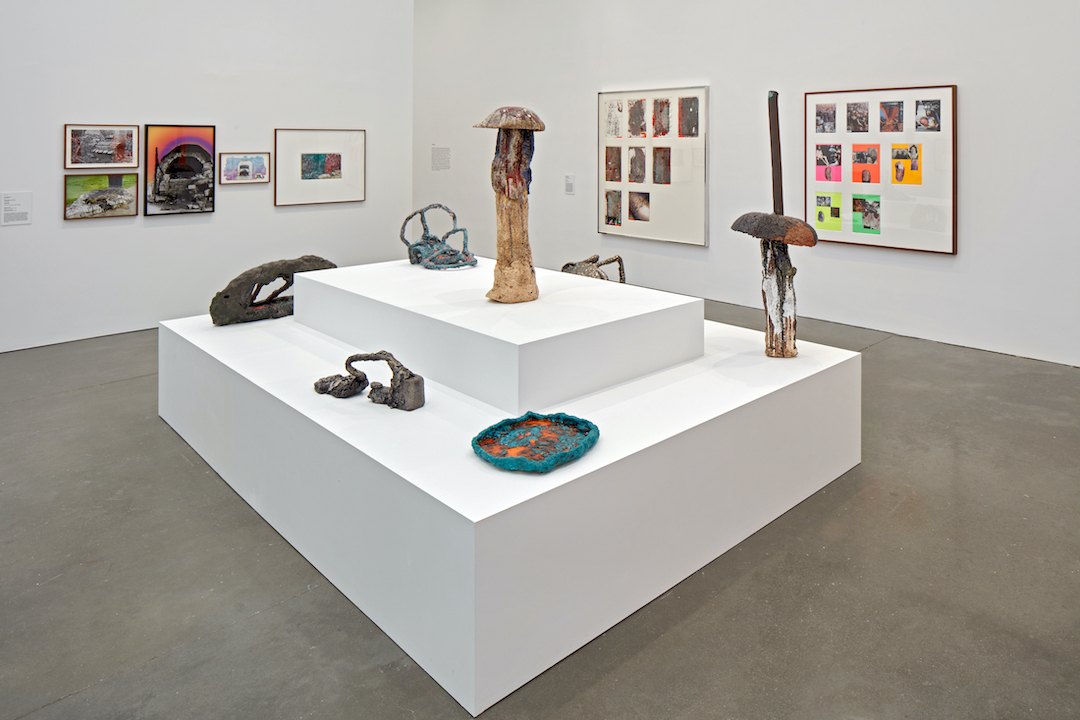
Installation view, Sterling Ruby, Institute of Contemporary Art/Boston, 2020. Courtesy Sterling Ruby Studio, Los Angeles. Photo by Charles Mayer. © Sterling Ruby
Throughout his career, Ruby has employed collage as a formal and conceptual mode of working, often experimenting with the medium to produce surprising results. He has described his approach to combining highly varied materials as an “illicit merger.” Ruby’s early collages, drawings, and prints provide a window into his artistic practice and preview the evolution of key themes in his work. Crystal Cryer (2001) suggests fraught invocations and instances of teardrops and stalagmite forms. Prison (2004) comprises one of Ruby’s first inquiries into the nature of confinement and institutions of power. Painted nails, pills, quilts, kilns, and imagery from cinema recur frequently throughout.
From left to right:
Top:
Girl in Kiln, 2004
Collage on paper
Bottom:
Transient Bed of John, 2003
Lambda print
Transient Bed of John (2003) contains some imagery essential to the artist’s understanding of Los Angeles: a tar pool contained with sandbags near the La Brea Tar Pits (an excavated fossil site from the Ice Age) by the Los Angeles County Museum of Art. Poked at by museumgoers during the day and often slept on by the homeless at night, these sandbags intrigued the artist. As layered, transient spaces, they reminded him of the very nature of the city, described by Ruby as a series of “activation sites of a variety of different curiosities… a strange mix of the prehistoric, the modern, the contemporary, the high and the low, the dirty, the polished.”
Kiln #1, 2005
Lambda print
Collection of Craig Robins and Jackie Soffer
STAR SKY, 2015
Collage, paint, and glue on paper
DRFTRS (6007), 2016
Collage, paint, and glue on paper
From left to right:
Pelican Bay Abstract, 2009
Collage and paint on paper
Nine collages, matted and framed
Ovitz Family Collection, Los Angeles
HRG Suite, 2005
Collage on paper
Nine collages, matted and framed
In these works the artist combines a variety of powerful motifs— from cinema, detention centers, Minimalist architecture, and space—to trace the influence of the grid as a paragon of modernist structure, regularity, order, and constraint. Dedicated to the artist H.R. Giger, HRG Suite (2005) features images of Giger’s ghoulish monster from the film Alien (1979), as well as references to the Scarecrow from The Wizard of Oz (1939), and the actress Linda Blair from The Exorcist (1973) among torsos of tattooed women, assailed political protestors, and a dense mob of US soldiers. These figures of trauma, transgression, and transformation mounted over vibrantly colored paper create a powerful visual presence that seems to protest against the pale, gridded matting holding them in strict quarters. Pelican Bay Abstract (2009), named after the infamous maximum security prison, contains colorful and frenzied abstraction within rigid, cell-like frames. The composition draws an evocative parallel to the prison’s sinister “correctional” confinement.
From left to right:
Pumpkin Head, 2008
Collage on paper
DRFTRS (4257), 2013
Collage, paint, and glue on paper
Head Trekkers 17, 2010
Collage on paper
The United States’ prison-industrial complex has long preoccupied Ruby, who from 2005–08 created a trio of exhibitions titled “SUPERMAX” after maximum-security prisons. These exhibitions featured sculptures, paintings, drawings, and collages installed densely to create a strong sense of claustrophobia. The orange paper used as the background for the collages—a nod to correctional facility uniforms—is combined with a variety of psychologically rich motifs, ranging from physical enhancement pills, to bloody horror movie stills from films like Pumpkinhead (1998), to idyllic landscapes contrasted with aerial and interior views of the notorious Pelican Bay State Prison. The artist equates this state of imprisonment—of being on permanent lockdown, in solitary confinement, and under sensory deprivation—to a dystopian view of contemporary society, politics, and violence. “This exists here and now, in America,” he says. “There is no redemption, only a state of detainment.”
From left to right:
DR (6503), 2017
Pen on paper
Snowball, 2001
Pencil on paper
Crystal Cryer, 2001
Pencil on paper
Prison, 2004
Collage and colored pencil on paper
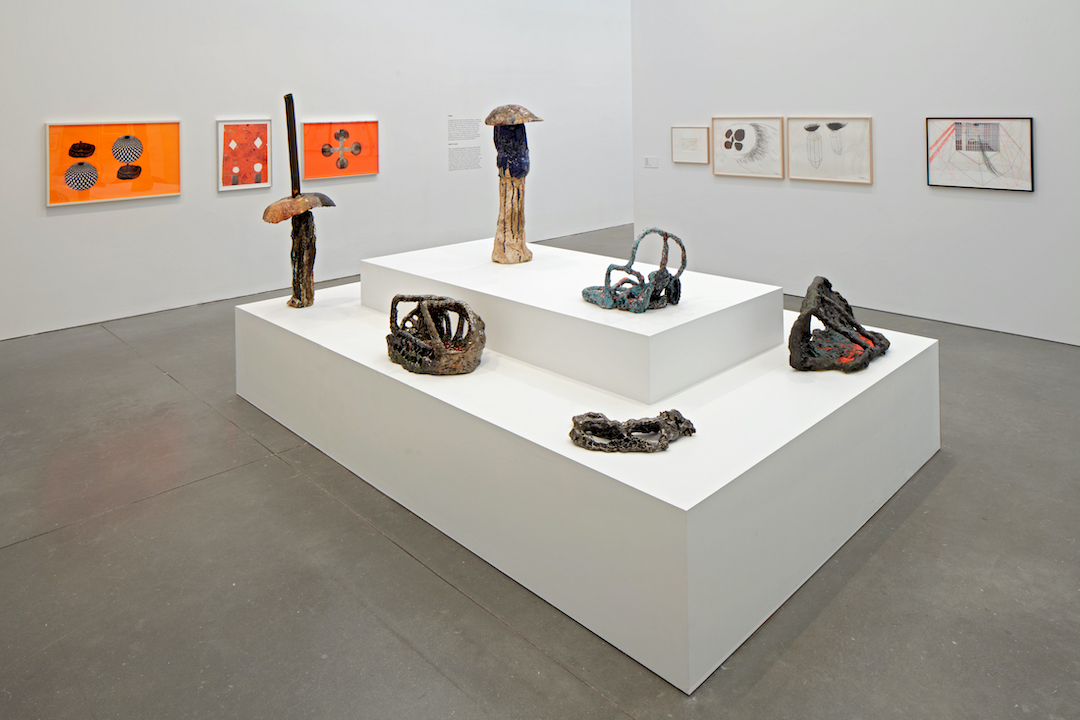
Installation view, Sterling Ruby, Institute of Contemporary Art/Boston, 2020. Courtesy Sterling Ruby Studio, Los Angeles. Photo by Charles Mayer. © Sterling Ruby
Ruby’s long-standing engagement with ceramic sculpture began in the early 2000s when he enrolled in a free-form clay class at a community art center while he was a student at the School of the Art Institute of Chicago. Intrigued by his mother’s collection of West German pottery, the notion of art therapy, and the California Clay Movement of the 1950s, Ruby has fostered a sustained fascination with the medium’s capacity for expressing gesture with a sense of immediacy. He brings various functional forms, such as ashtrays or basins, into the realm of sculpture. Ruby has also transformed these ceramics into other media, such as casting them in bronze, depicting the hand-worked characteristics of a medium associated with craft in one of sculpture’s most enduring materials.
| ASHTRAY 141, 2010 Ceramic |
|
| ACTRESS 2, 2010 Bronze with silver nitrate patina |
|
| TROOPER, 2017 Ceramic Private collection |
|
| Modern Brass/ Ketamine User, 2012 Ceramic Collection of Maurice Marciano |
|
| Hiker (4949), 2014 Bronze with silver nitrate patina |
|
| Drive-Thru Pewter Facial, 2010 Ceramic Collection of Thomas H. Lee and Ann Tenenbaum |
|
| Blue Angel, 2007 Ceramic |
|
| ANGLE OF DEPRESSION, 2017 Ceramic |
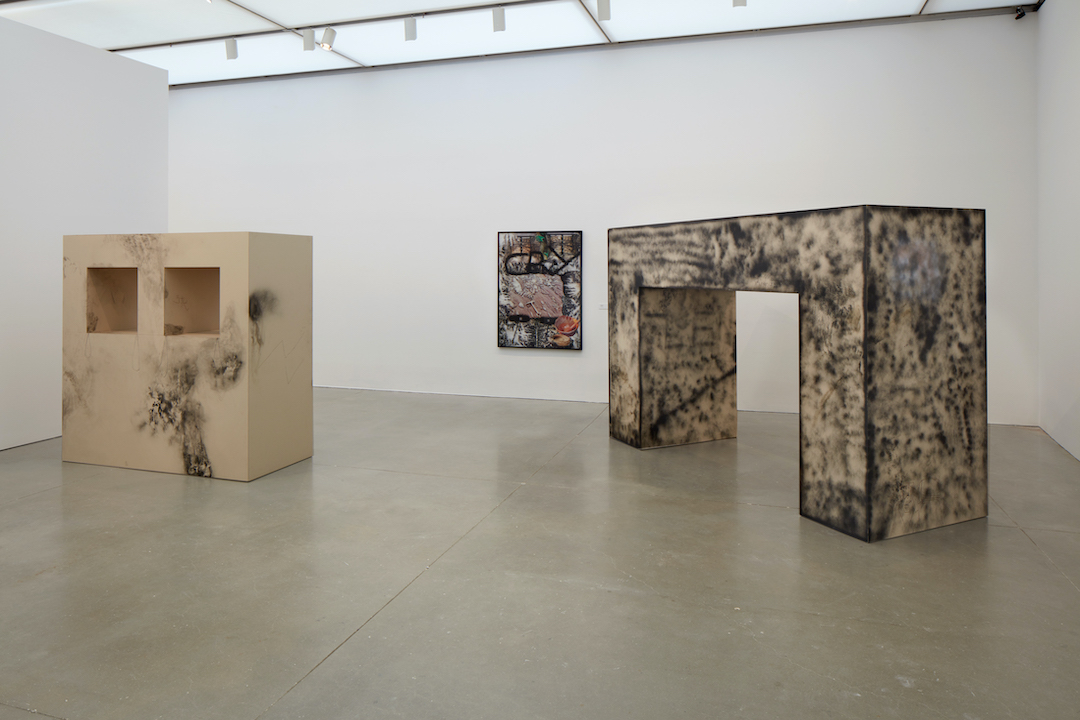
Installation view, Sterling Ruby, Institute of Contemporary Art/Boston, 2020. Courtesy Sterling Ruby Studio, Los Angeles. Photo by Charles Mayer. © Sterling Ruby
Ruby’s series of geometric solids, formica monoliths in different shapes and orientations that he often tags with spray paint or otherwise inscribes, reveal his approach to grappling with the historical legacy of Minimalism in sculpture. In Big Grid/DB Deth (2008), for example, the artist has defiled the white, geometric construction with black spray paint and etched inscriptions. ZEN RIPPER (2008) exhibits a similar approach.
From left to right (in photo):
Big Grid/DB Deth, 2008
Formica, spray paint, and wood
ZEN RIPPER, 2008
Formica, spray paint, and wood
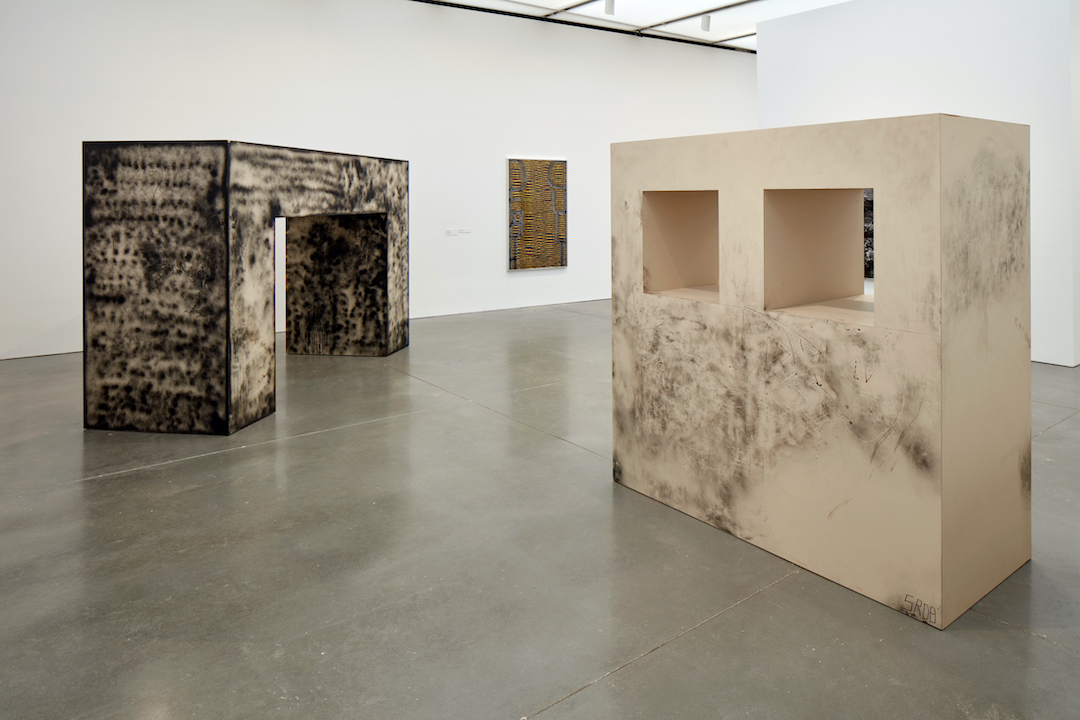
Installation view, Sterling Ruby, Institute of Contemporary Art/Boston, 2020. Courtesy Sterling Ruby Studio, Los Angeles. Photo by Charles Mayer. © Sterling Ruby
Since 2005, Ruby has made color photographic prints (referred to as C-prints) that extend the formal strategies of collage into photography, allowing him to integrate ever more diverse references. Layered, rearranged, and digitally manipulated, these prints result in a dynamic collision of found and reworked images and motifs.
Cry 2005 (2005), a chaotic patchwork of images featuring bleached fabric, spray-painted plywood, and glazed ceramics, is scrawled over in bold, black graffiti that spells out “CRY.” While the poignant word suggests an anxious, raw, or vulnerable mode of expression, the method of inscription carries a rebellious and menacing quality, emphasized by the pair of eyes below it. The central image of what seems like an archeological site highlights the artist’s practice of digging through his studio and “cannibalizing” or reworking materials and motifs.
Cry 2005, 2005
Lambda print
Private collection
Death Cult (6150), 2016
Archival inkjet print
Death Cult (6148), 2016
Archival inkjet print

Installation view, Sterling Ruby, Institute of Contemporary Art/Boston, 2020. Courtesy Sterling Ruby Studio, Los Angeles. Photo by Charles Mayer. © Sterling Ruby
Following Ruby’s geometric solids, the works in a subsequent series, ACTS (Absolute Contempt for Total Serenity) (2006–18), capture liquid dyes in clear urethane blocks that balance atop scratched-up and spray-painted formica bases. The suspended pigments are fixed between liguid and solid states, disrupting the purity of the prism. The formica volumes embody Minimalist forms and colors, while Ruby’s aggressive gestures on the assembled configurations disrupt their uniformity.
In this room:
From left to right (in photo):
ACTS/WS ROLLIN, 2011
Clear urethane block, dye, wood, spray paint, and formica
Institute of Contemporary Art, Miami; Gift of The Hinson Family, by exchange
SCXV3ST/BD, 2012
Fiberglass, wood, spray paint, and formica
ACTS/ 187 DREAMER, 2009
Clear urethane block, dye, wood, spray paint, and formica
Collection of Andre Sakhai, New York
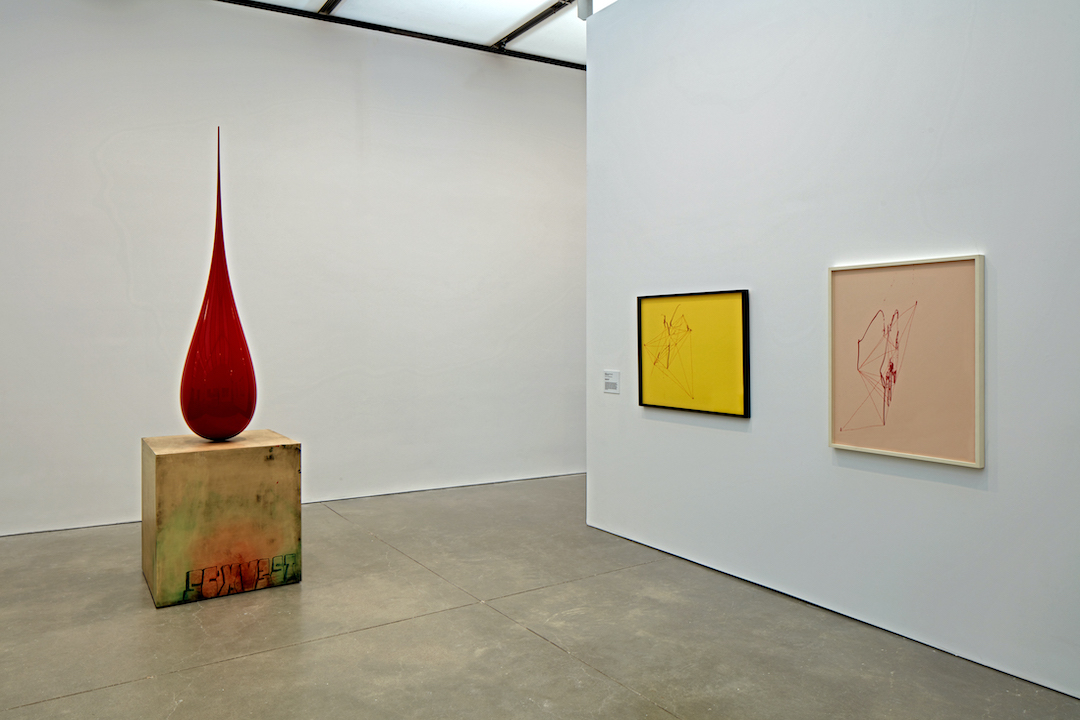
Installation view, Sterling Ruby, Institute of Contemporary Art/Boston, 2020. Courtesy Sterling Ruby Studio, Los Angeles. Photo by Charles Mayer. © Sterling Ruby
Ruby’s Mapping (2003–09) series features the signature linear mark-making technique of his early drawings and collages, though here he applies only nail polish on brightly colored paper. Nail polish persists as a material in Ruby’s collages for the gendered associations it calls forth. Each drawing comprises an esoteric map-like composition of rigid, interconnected lines disrupted by drops and smears of nail polish that resemble blood, lending ominous overtones to otherwise rudimentary, abstract works.
From left to right:
(Mapping) Jordache Nail Polish, 2005
Nail polish on paper
Collection of Andre Sakhai, New York
Mapping (Pink), 2005
Nail polish on paper
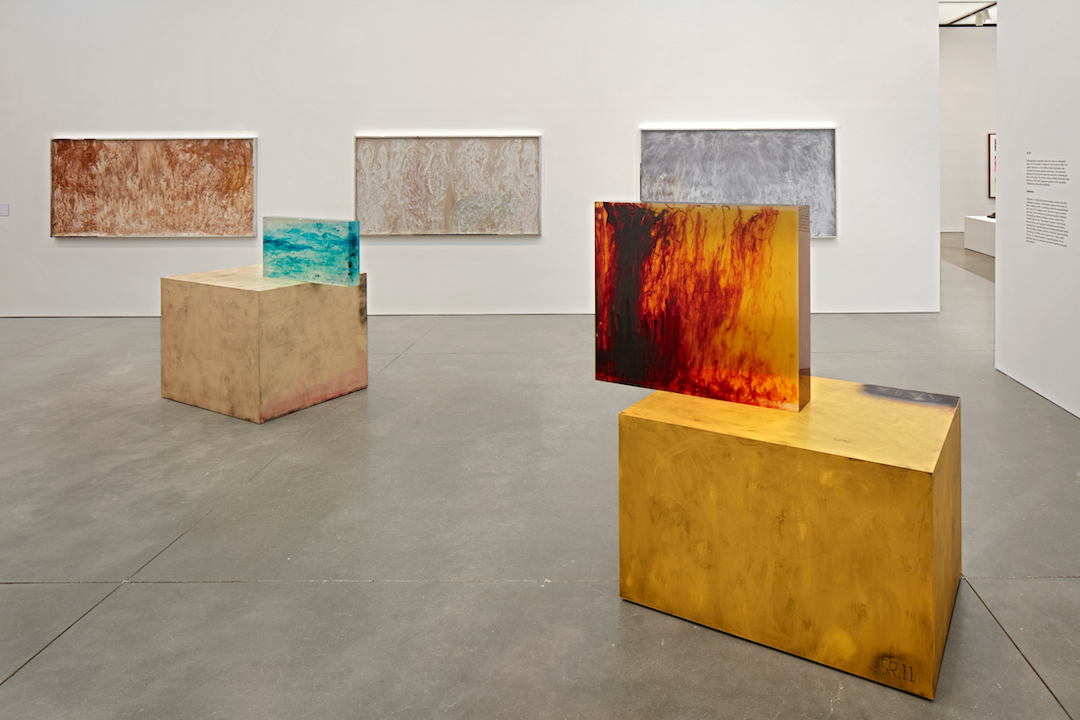
Installation view, Sterling Ruby, Institute of Contemporary Art/Boston, 2020. Courtesy Sterling Ruby Studio, Los Angeles. Photo by Charles Mayer. © Sterling Ruby
Alabaster is a mineral rock used for centuries for statuary, carvings, and other ornaments. The beautiful expanse of cast acrylic in Ruby’s Alabaster (2006–11) paintings recalls the suspended liquid dyes in his ACTS sculpture sries, which were made around the same time, while referring to the translucent quality of alabaster. These paintings balance an ethereal, yet heavy quality, like a moment frozen in time. They display a dynamic visual tension between fluidity and coagulation, defacement and decoration, mirroring Ruby’s sustained practice of adopting Minimalist forms while searching to liberate such forms from their inherent rigidity. “Everything I do holds a kind of gesture in it,” Ruby recalls. “For me, it’s a dramatic gesture. A truncated gesture. It’s like an expression that was at one point very fervent and then it just gets frozen, halted.”
From left to right:
Alabaster SR08-2, 2008
Cast acrylic
Alabaster SR10-16, 2010
Cast acrylic
Collection of Javier and Monica Mora
Alabaster SR11-58, 2011
Cast acrylic
Collection of Ray Ellen and Allan Yarkin, Miami

Installation view, Sterling Ruby, Institute of Contemporary Art/Boston, 2020. Courtesy Sterling Ruby Studio, Los Angeles. Photo by Mel Taing. © Sterling Ruby
At times satirical and at others melancholic, Ruby’s soft sculptures are large-scale cartoons made from stuffed textiles. Often immersive, the works invoke monuments in their size, although their soft textures seem to contradict their own potency. Influenced by Ruby’s childhood experience with Amish quilt-making in rural Pennsylvania, these works embody the artist’s attraction to craft and its connotations relating to gender and modernity. Ruby has used fabric with many motifs; the installation here includes works with a US flag pattern, suggesting. the artist’s critical views of patriotism and violence. These confrontational works can pack a grotesque punch: DOUBLE VAMPIRE 14 (2013) forms sneering, parted lips and fangs dripping with blood. DOUBLE CANDLE (6992) (2019) suggests domestic life and ritual, but also mourning. A new installation, FIGURES. PILE. (6991) (2019), depicts a heap of interconnected bodies tagged with the American flag, highlighting the innate connections and collisions among bodies during war and disaster.
Clockwise from right:
VAMPIRE 129, 2014
Fabric and fiberfill
QUILT (4858), 2014
Bleached and dyed canvas and elastic
DOUBLE CANDLE (6992), 2019
Fabric and fiberfill
FIGURES. PILE. (6991), 2019
Fabric, yarn, and fiberfill
DOUBLE VAMPIRE 14, 2013
Fabric and fiberfill
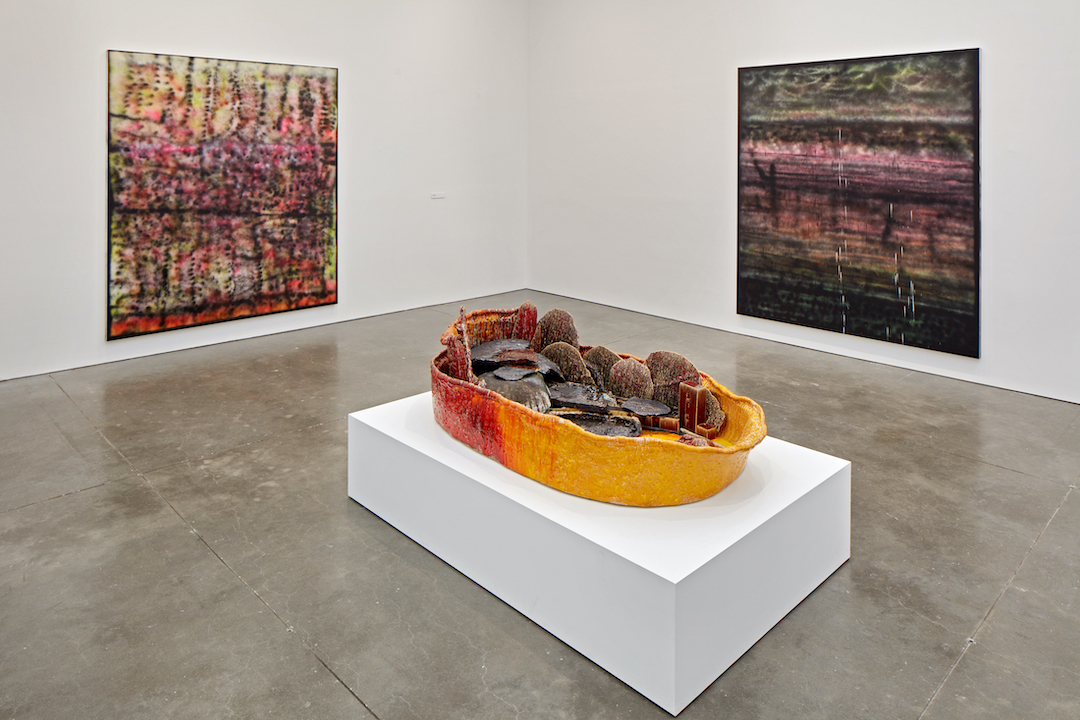
Installation view, Sterling Ruby, Institute of Contemporary Art/Boston, 2020. Courtesy Sterling Ruby Studio, Los Angeles. Photo by Charles Mayer. © Sterling Ruby
Around 2003 Ruby bagan implementing a variety of spray painting techniques in different mediums to create textured grounds for his colalges on paper or as a means of tagging and defiling the uniformity of his formica sculptures. In 2007 he made his first monumental spray paintings on canvas, a series called SP (2007–14). Each work is an atmospheric color field painting worked extensively by hand with an abstract lexicon of overlapping dots, drips, lines, and shapes. Introduced to graffiti at a young age, Ruby developed an interest in such forms of renegade expressivity thanks to his proximity to the Washington, DC punk scene and later the spray-painted gang insignia around Los Angeles. Utilizing a material often seen as transgressive or subcultural, Ruby’s use of spray paint explores a broad range of cultural, historical, and formal associations.
SP04, 2007
Spray paint on canvas
SP49, 2008
Spray paint on canvas
Private collection, New York
SP131, 2010
Spray paint on canvas
SP242, 2013
Spray paint on canvas
Whitney Museum of American Art, New York; Gift of Guy Starkman
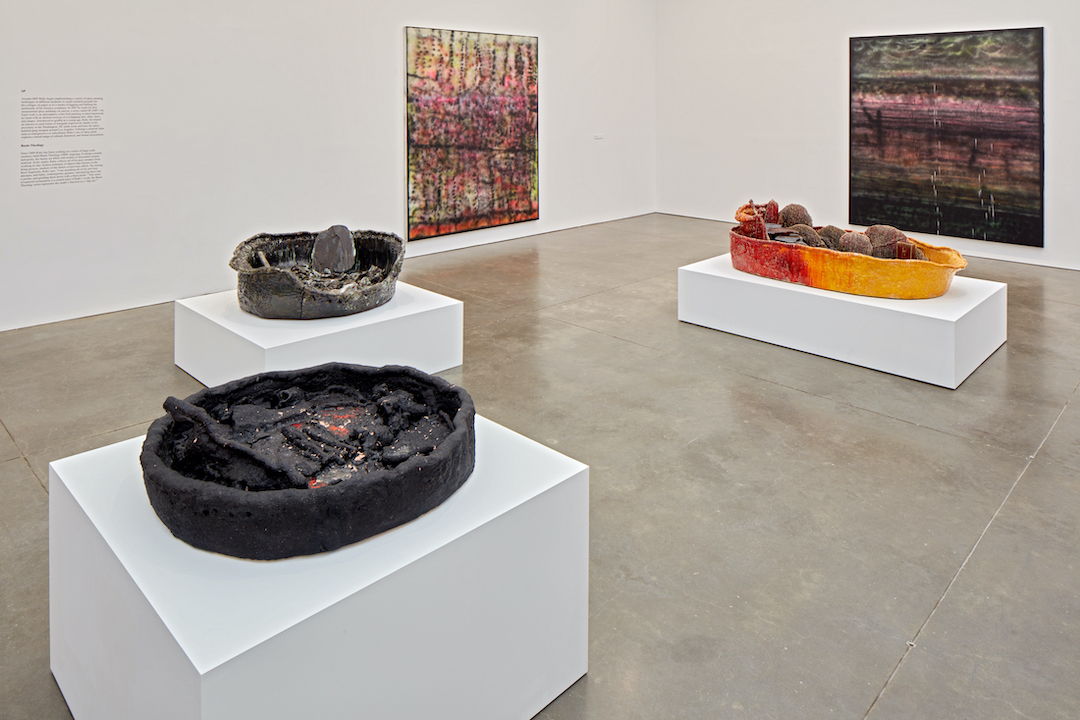
Installation view, Sterling Ruby, Institute of Contemporary Art/Boston, 2020. Courtesy Sterling Ruby Studio, Los Angeles. Photo by Charles Mayer. © Sterling Ruby
Since 2009 Ruby has been working on a series of large-scale ceramics titled Basin Theology (2009–ongoing). Evoking a mortar and pestle, the basins are filled with broken or discarded ceramic material. In his studio, Ruby collects all of his past mistakes from working in clay: broken remnants of objects that fracture in the firing process, markers of the failure of previous efforts. By reusing these fragments, Ruby says, “I am smashing all of my previous attempts, and futile, contemporary gestures, and placing them into a mortar, and grinding them down with a blunt pestle.” This sense of material reclamation is a central tenet of Ruby’s work; the Basin Theology series represents the studio’s function as a “dig site.”
From left to right (in photo):
Basin Theology/LA BREA 2, 2011
Ceramic
Ovitz Family Collection, Los Angeles
Basin Theology/CRYPTOCRYSTALLINE, 2016
Ceramic
Basin Theology/HELIOS BOAT, 2019
Ceramic
Collection of Charlotte and Herbert S. Wagner III, Boston
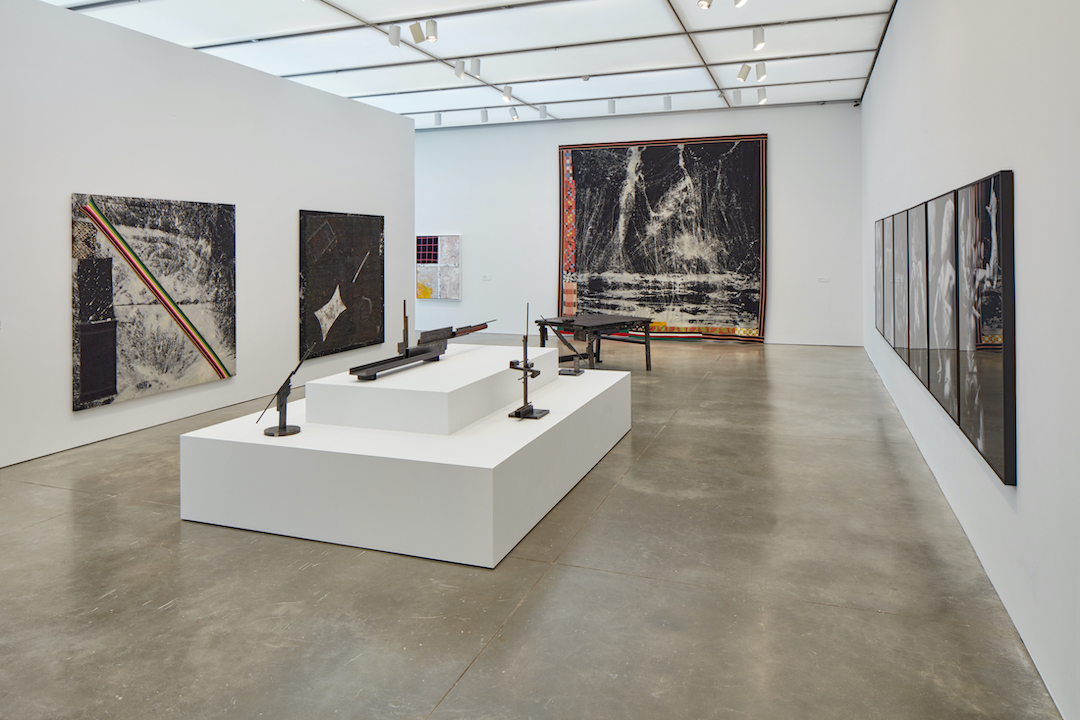
Installation view, Sterling Ruby, Institute of Contemporary Art/Boston, 2020. Courtesy Sterling Ruby Studio, Los Angeles. Photo by Charles Mayer. © Sterling Ruby
During a month-long stay at the Chinati Foundation in Marfa, Texas, in 2010, near the United States-Mexico border, Ruby began a series of welded and cut steel sculptures he refers to as MS (metal sculptures) (2010–11). Made from widely used industrial materials such as plate metal and rebar, these works range in scale from tabletop assemblages to large, freestanding sculptures. Many of the MS works are pockmarked with crude welds that achieve a makeshift aesthetic. Ruby’s TABLE 4 (2015) is similarly marked, though the aberrations in form also point to decades of industrial use. In 2015 Ruby moved into a studio just outside of Los Angeles and salvaged the welding tables left behind from the building’s previous life as an industrial warehouse. By covering these steel work tables with jutting scrap metal and tumorigenic masses of solder during the production of his own welding projects, Ruby memorializes the industrial labor that once took place on their surfaces. The table becomes a hulking, organic being—a haunting archaeological remnant from some unnamed human history.
FLAG/QUILT (6625), 2018
Bleached denim, treated fabric, and elastic
See soft sculpture
Opposite:
TABLE 4, 2015
Steel
| MS06-2872, 2010 Steel |
|
| MS07-2873, 2010 Steel |
|
| MS13-2879, 2010 Steel |
|
| MS01-2867, 2010 Steel |

MS16-2883, 2010
Steel

Installation view, Sterling Ruby, Institute of Contemporary Art/Boston, 2020. Courtesy Sterling Ruby Studio, Los Angeles. Photo by Charles Mayer. © Sterling Ruby
Foundational to Ruby’s practice, collage infuses all of his artistic output: from his early works on paper to his DRFTRS (2012–ongoing) series, collage-hybrids of images set against expressionsitic landscapes; from his WIDW (2016–ongoing) paintings, layered with cut cardboard and fabric swaths, to his bleached BC (2011–15) canvases, pasted over with colorful fabric. The BC series evolved out of Ruby’s studied consideration of quilting and his technique of reusing discarded materials leftover from works in other mediums. For these pieces, he treats each fabric panel with poured or splattered bleach before collaging them with fabric scraps, found clothing, and other textiles, such as moving blankets or strips of colorful fabric.
From left to right:
BC (5289), 2014
Fabric, glue, and bleached canvas on panel
BC (3950), 2012
Fabric, paint, glue, and bleached canvas on panel
Opposite:
Physicalism/The Recombine 1-6, 2006
Lambda prints
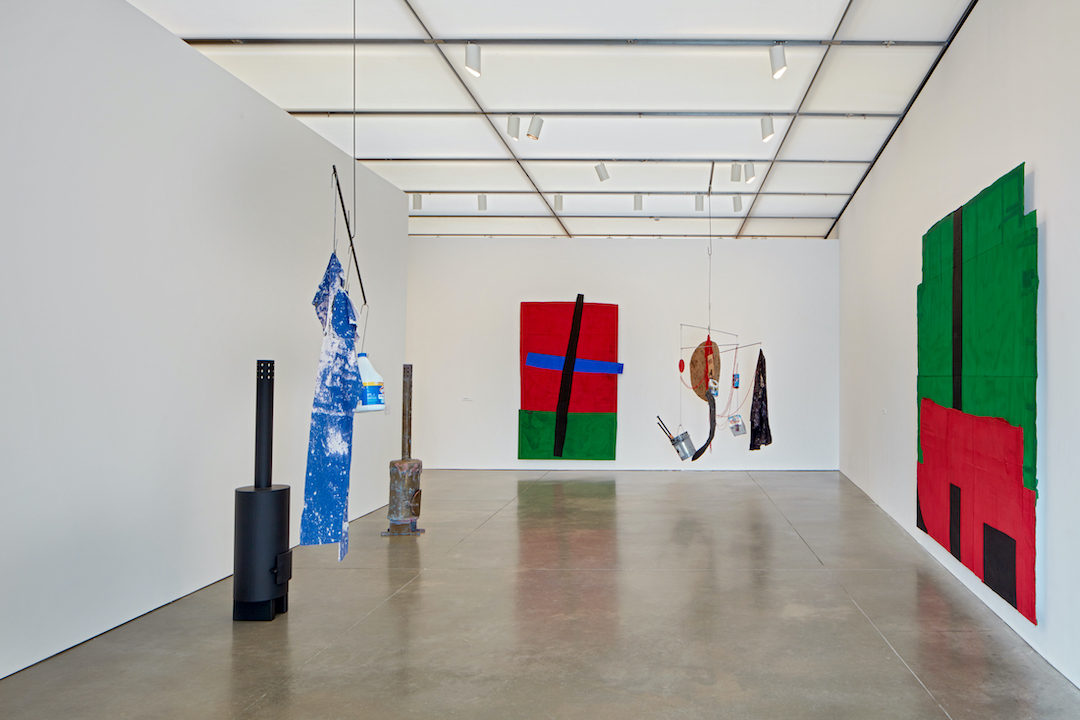
Installation view, Sterling Ruby, Institute of Contemporary Art/Boston, 2020. Courtesy Sterling Ruby Studio, Los Angeles. Photo by Charles Mayer. © Sterling Ruby
During a trip to China in 2011, Ruby observed workers in a foundry using leftover materials to construct makeshift furnaces. Configured during harsh winters, these roughly welded structures would then be disassembled in the next season. The stoves reminded Ruby of tending to his family’s wood-burning stove as a child. In 2012 he began to create his own as sculpture. Whether in textured, patinated bronze or sleekly polished steel, Ruby’s STOVES (2012–14) embody an industrial look. Their forms suggest that they could provide heat and create a warm, communal space, yet few function or burn wood. Most rest dormant, appearing, in the artist’s words, “almost like relics.” The STOVES also reference Ruby’s ceramics practice, although he does not use them to fire the forms for which he is so well known. Instead, they breed tension between manufacturing and artistic production, while highlighting reuse and the transformational qualities that are foundational to his work.
From left to right:
STOVE 4, 2013
Painted stainless steel
STOVE 3, 2012
Bronze and paint
Collection of Isabel and Ricardo Ernst

Installation view, Sterling Ruby, Institute of Contemporary Art/Boston, 2020. Courtesy Sterling Ruby Studio, Los Angeles. Photo by Charles Mayer. © Sterling Ruby
In Ruby’s studio, throwaway materials are often incorporated into new works, carrying forward fragments of previous pieces into newer bodies. Here, Ruby has repurposed pieces of cardboard from his studio for ECLPSE (2014–15), a series of large-scale abstract collages. The cardboard has been cut into shapes that resemble suns, moons, or other landscape elements, painted in primary colors, and arrayed in various configurations. The richly painted pieces of cut cardboard and Ruby’s pattern of reuse recur in SCALES (2013–18) his series of self-referential mobiles. Monumental three-dimensional hanging collages, these works often juxtapose cardboard shapes with other recognizable elements from Ruby’s creative output. These materials introduce different narrative elements and function as a compendium of Ruby’s studio practice and the studio itself.
SCALE (4586), 2013
Steel, paint, cardboard, yarn, and mixed media
SCALE (5415) S.R. CLOR., 2015
Steel and mixed media
ECLPSE (GRB), 2015
Collage and paint on cardboard
ECLIPSE (RBGBCROSS), 2015
Collage and paint on cardboard
From left to right:
ENGULFED COROLLA, 2017
Acrylic, oil, elastic, and cardboard on canvas
Collection of the Witkoff Family, Miami
HOT FLAT LIGHT, 2017
Acrylic, oil, elastic, and cardboard on canvas
Private collection
Sterling Ruby is organized by Eva Respini, Barbara Lee Chief Curator, ICA/Boston, and Alex Gartenfeld, Artistic Director, ICA, Miami, with Jeffrey De Blois, Assistant Curator and Publications Manager, ICA/Boston.
Sterling Ruby is on view at ICA, Miami November 7, 2019 – February 2, 2020.
Major support for Sterling Ruby is provided by Sprüth Magers, Gagosian, and Xavier Hufkens.

Additional support for the Boston presentation is generously provided by Stephanie Formica Connaughton and John Connaughton, Jean-François and Nathalie Ducrest, Bridgitt and Bruce Evans, James and Audrey Foster, Ted Pappendick and Erica Gervais Pappendick, David and Leslie Puth, and Charlotte and Herbert S. Wagner III.